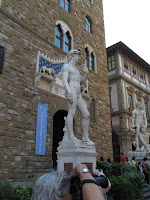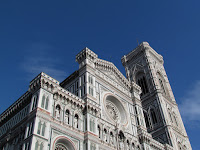 Monday, July 18 – San Miniato al Monte
Monday, July 18 – San Miniato al Monte  High on a hill overlooking Florence sits San Miniato al Monte, a Romanesque church built in the 12th Century. It is home to Olivetan monks, their monastery, and a cemetery. The church exterior is an elegant detailed mosaic of polished marbles while inside, roughly carved wood timbers support the roof and simple wooden pews provide an earthly religious setting. An echo drew us to the front of the church where three monks sat facing each other. Their lips barely moved, but their chanting reverberated through the building and over the rooftops of Florence below.
High on a hill overlooking Florence sits San Miniato al Monte, a Romanesque church built in the 12th Century. It is home to Olivetan monks, their monastery, and a cemetery. The church exterior is an elegant detailed mosaic of polished marbles while inside, roughly carved wood timbers support the roof and simple wooden pews provide an earthly religious setting. An echo drew us to the front of the church where three monks sat facing each other. Their lips barely moved, but their chanting reverberated through the building and over the rooftops of Florence below. Behind the church is a cemetery. It appears to be designed in blocks graves with a block expansion when the last block filled. As expected, the names on the grave stones are Italian. Unexpected are the monuments and elaborate statuary. The early morning shadows and light beams cast a magical inviting aura over the city of the dead, begging a photographer wander the grounds and visit the souls.
With the exception of the door knob on the front door, which is positioned at my eye level (five feet higher than the sidewalk), a shoulder high key hole, and 14’ ceilings all things in our flat seem small. Reaching up makes me feel very small. When we enter or leave, people on the street look at us as if to jealously say, “Oh, they live here.” At least that’s what I imagine them to say except for our upstairs neighbors, who I have named Marcello and Sophia, who know we are transient and that the bats fly in the building at will. I call this living space a flat while others call it an apartment or a house. I call it a flat because it is linear with one room in front of the other from the entrance door in the stair well to the great room with windows overlooking the street. We have a tiny two cup espresso pot, two tiny espresso cups, tiny wine glasses that double as juice glasses, purchased at the l’Italia 99 cent store, and we eat with espresso spoons and salad forks. Our colorful nativity sponges are each the size of a deck of cards and although there are ten, we ration their use so as not to disturb the nativity scene. The first selected was yellow and green, a familiar color for a sponge. The next selected was red and green, a tradition color referencing Christmas.
Thursday, July 21 – Accademia

 The Accademia is less than two blocks away, but we only walk that section of the street on Monday when it is closed. On other days, crowds in cue and souvenir vendors flood the street as if they were waiting to enter a building which housed one of the most recognizable statues in the world, in fact it does, Michelangelo’s Statue of David. Its reproduction, in the outdoor Piazza della Signoria, looks of average size as it stands in a loose cluster of naked marble men and women in various poses. In the Accademia however, the nine head tall David stands on a pedestal by himself under a sky-lit dome. He is, in one word, magnificent – his entire 360 degree view.
The Accademia is less than two blocks away, but we only walk that section of the street on Monday when it is closed. On other days, crowds in cue and souvenir vendors flood the street as if they were waiting to enter a building which housed one of the most recognizable statues in the world, in fact it does, Michelangelo’s Statue of David. Its reproduction, in the outdoor Piazza della Signoria, looks of average size as it stands in a loose cluster of naked marble men and women in various poses. In the Accademia however, the nine head tall David stands on a pedestal by himself under a sky-lit dome. He is, in one word, magnificent – his entire 360 degree view. |
English Mass In the Duomo
 Today was Saturday and as I learned last week, you can walk in the side door of the Duomo at 4:50 at attend 5pm mass in English. I felt very comfortable in the cathedral when I was there with my parents in 1958 and felt the same at mass last week. The priest spoke of facing challenges and having hope; this week he spoke of making sacrifices and having faith.
Today was Saturday and as I learned last week, you can walk in the side door of the Duomo at 4:50 at attend 5pm mass in English. I felt very comfortable in the cathedral when I was there with my parents in 1958 and felt the same at mass last week. The priest spoke of facing challenges and having hope; this week he spoke of making sacrifices and having faith.In the Piazza del Duomo
We cleared out at 5:50 for the 6pm mass in Italian. Emerging from the peace of the sanctuary, just as last week, tourists were crowded all around the Duomo, as if they had no idea what was taking place inside. They chatted, ate gelato, and when the chimes rang at 6pm, in unison they (all 2,000) seemed to turn and raise their cameras to the cathedral, rhythmically snapping photos as if the chimes somehow would enhance the image or perhaps bring back that special memory when they returned home. When the chimes stopped, the shutters stopped, and they returned to eating gelato.
 ...when the bat flew into our flat, the noise we caused running up and down the hall, Barbra with broom in hand, caused Marcello and Sophia to look down on us from their windows in the shaft. I quickly searched the Italian/English dictionary for the word bat and only found uccello the word for bird. To explain our situation, I stood in front of our shaft window flapping my arms using the international symbol for bat and repeating, “Uccello, uccello." They just looked at us with furrowed brows probably thinking, “Whatsa the biga deal – it’s a only a bata anda ifa theya shita ona youra heada itsa gooda luck.” After mass at the Duomo, I watched a woman laugh hysterically as she poured water on her husband’s head while he washed out the dung…and the good luck.
...when the bat flew into our flat, the noise we caused running up and down the hall, Barbra with broom in hand, caused Marcello and Sophia to look down on us from their windows in the shaft. I quickly searched the Italian/English dictionary for the word bat and only found uccello the word for bird. To explain our situation, I stood in front of our shaft window flapping my arms using the international symbol for bat and repeating, “Uccello, uccello." They just looked at us with furrowed brows probably thinking, “Whatsa the biga deal – it’s a only a bata anda ifa theya shita ona youra heada itsa gooda luck.” After mass at the Duomo, I watched a woman laugh hysterically as she poured water on her husband’s head while he washed out the dung…and the good luck. 









































